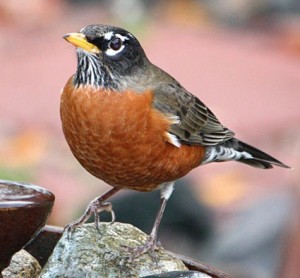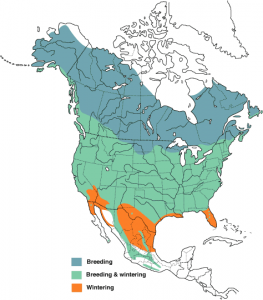American Robins (Turdus migratorious), one of the largest thrushes in North America, are a fairly common sight in most American backyards. They are mostly found in woodland, forests and gardens. They have an orange breast with a black/brown back and wings. They have a short, pointed yellow bill with a black head and a white supercilium.

When foraging for food, usually near cover such as short grass and shrubs, American Robins mostly walk but may also hop if the vegetation is slightly tall. They mainly feed on invertebrates such as earthworms and fruits, and are intoxicated if they only feed on honeysuckle berries. During the winter, they usually sunbathe and flocks may sometimes gather in trees to roost. Preening and bathing are common activities during the day.
Generally, American Robins are socially and sexually monogamous. Breeding primarily occurs in areas with short grass, trees and shrubs such as residential areas. A pair normally raises two broods per year but some pairs have been known to raise up to three broods per year. Their breeding season begins in early spring, from April through July. Females are primarily in charge of building the nests but males also help in bringing building materials to the nest site. The female incubates the eggs, usually for brief periods of up to 45 minutes. A male may sometimes bring food to an incubating female. The female broods the chicks after the eggs hatch and continues to do so until they are older, after which she only broods them at night and during inclement weather. After two weeks, chicks are capable of flying. At this time, both the female and the male continue feeding and protecting the chicks until they are fully capable of foraging on their own. 
As ubiquitous as the American Robin is, more information is needed on the significance of the different types of vocal communication it uses. Further research is needed to determine the significance of the hisselly and caroled phrases in regard to female attraction. A playback experiment can be conducted to determine the significance of the two phrases in mate attraction. The scientists can record a male’s caroled and hisselly phrases and then play them back to captive female robins and record how many females perform a copulation display in response to each phrase. A stuffed male in the wild, during breeding time can also be used. The experimenters can playback the different phrases and record how many females approach the stuffed male.
References:
- Vanderhoff, Natasha, Rex Sallabanks and Frances C. James. 2014. American Robin (Turdus migratorius), The Birds of North America Online (A. Poole, Ed.). Ithaca: Cornell Lab of Ornithology; Retrieved from the Birds of North America Online: http://bna.birds.cornell.edu/bna/species/462 doi:10.2173/bna.462
- Kroodsma, D. 2005. Beginnings In: Kroodsma, D. (eds) The Singing Life of Birds: The Art and Science of Listening to Birdsong. New York, New York, pp. 23-41.

Another cavity nester (e.g. house sparrow) or a brood parasite (cowbird) might kill, but not eat the young . Another possibility is that the latch failed and the female wasn’t able to effectively brood the young.
Cool!
Just wanted to let you know that there was a white headed robin on The field w the soccer goals near Walker fieldhouse. Saw him on 4/12/18.
I have been actively attracting eastern bluebirds to my backyard for five years now and with some unusual incidents. Last year something pulled the door open (latch still in place) and killed the four babies but did not eat them. This year, a robin has been aggressively harassing the bluebird pair but I know their eggs have hatched because I have seen the bluebirds removing the egg shells. Yesterday as I was walking in my garden near the bluebird house, this robin became aggressive towards me! It was if she had eggs in the house! Any clues or ideas? There is nothing remotely nearby the robin could have a nest in.